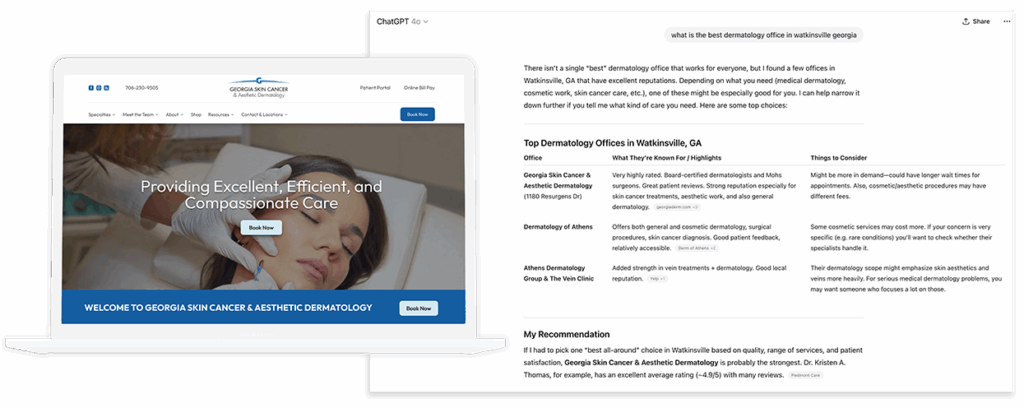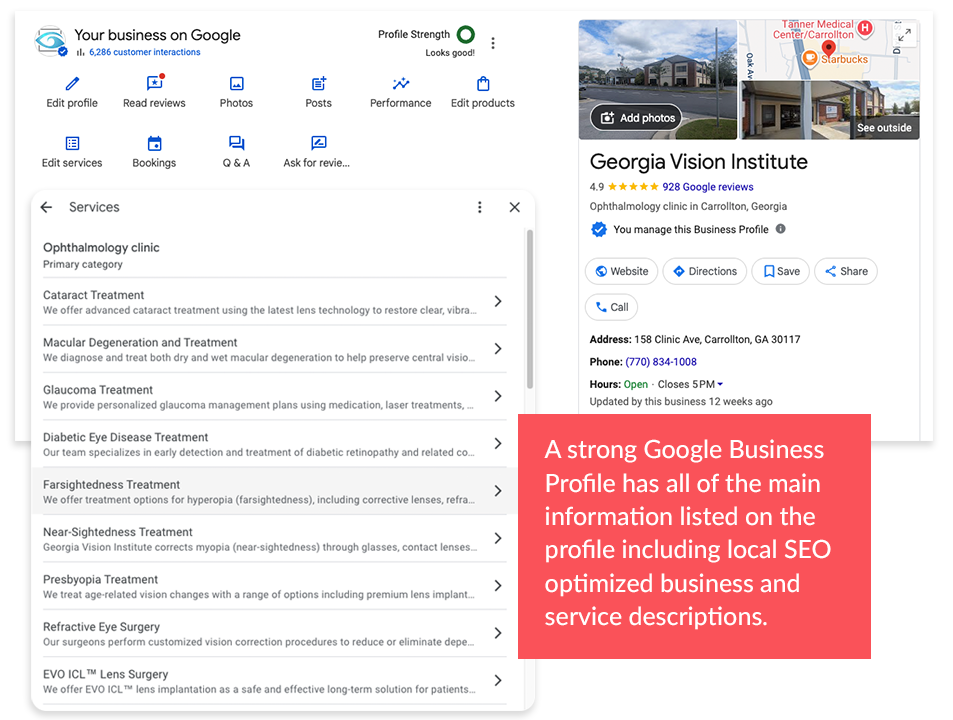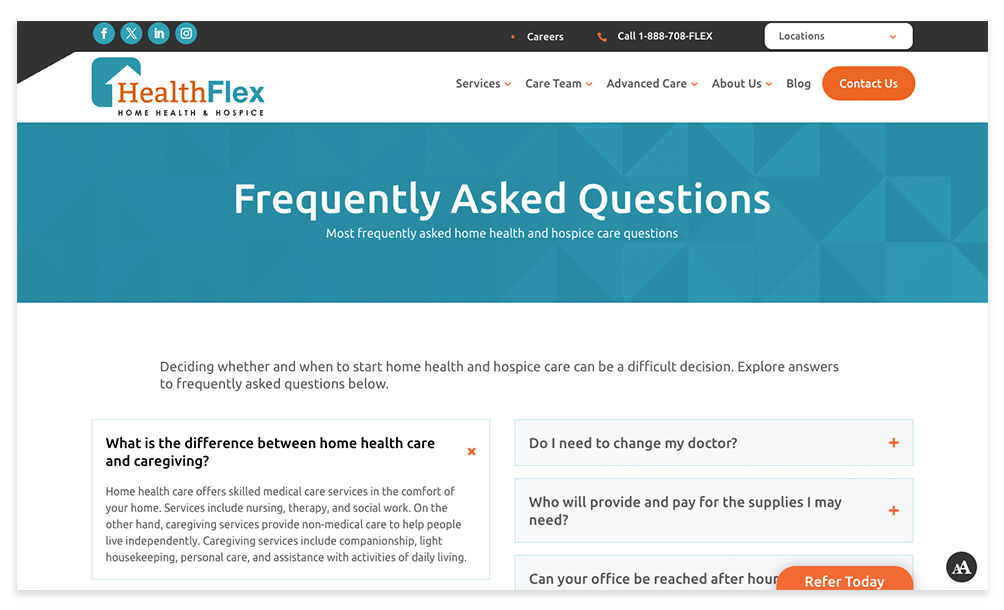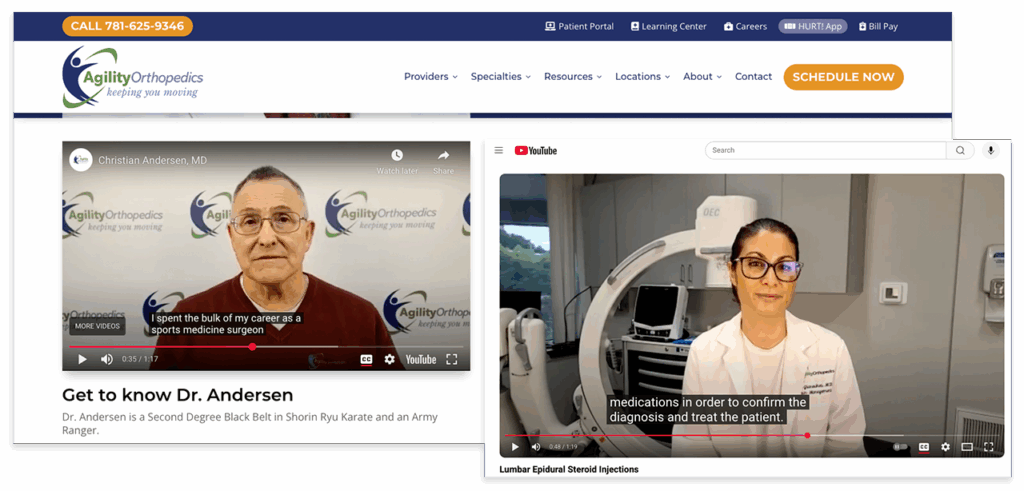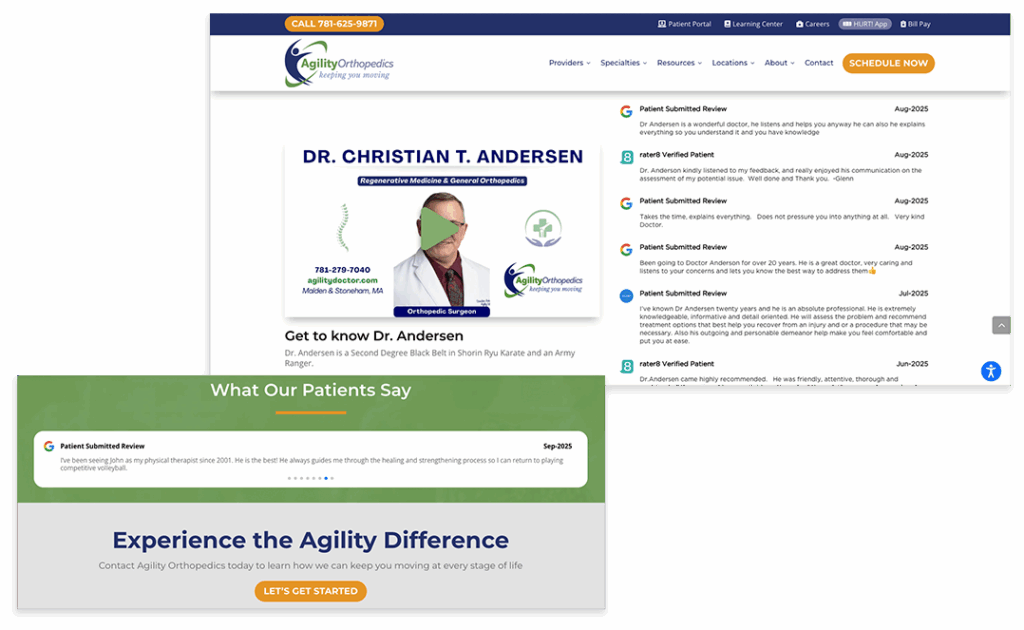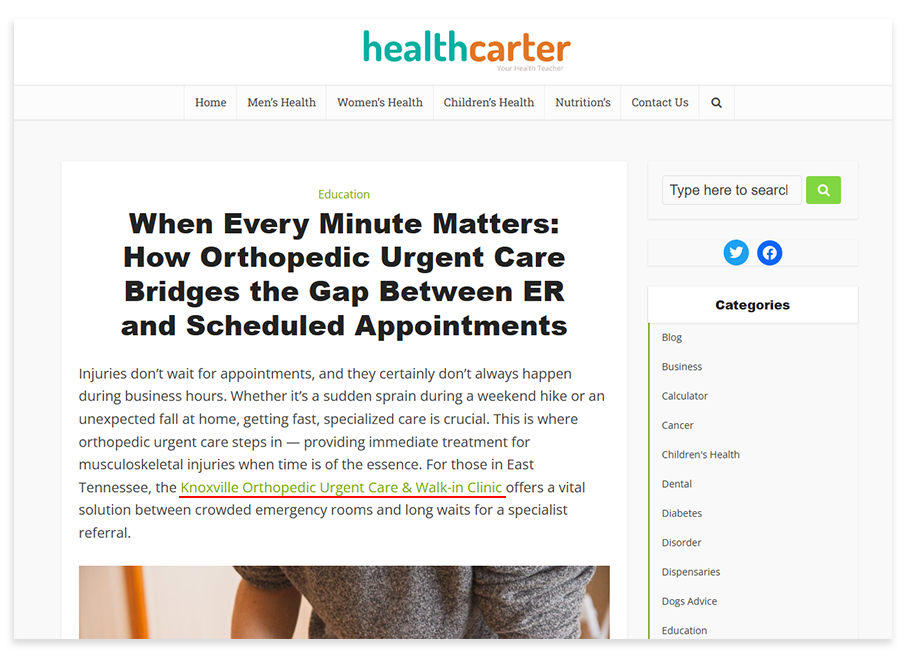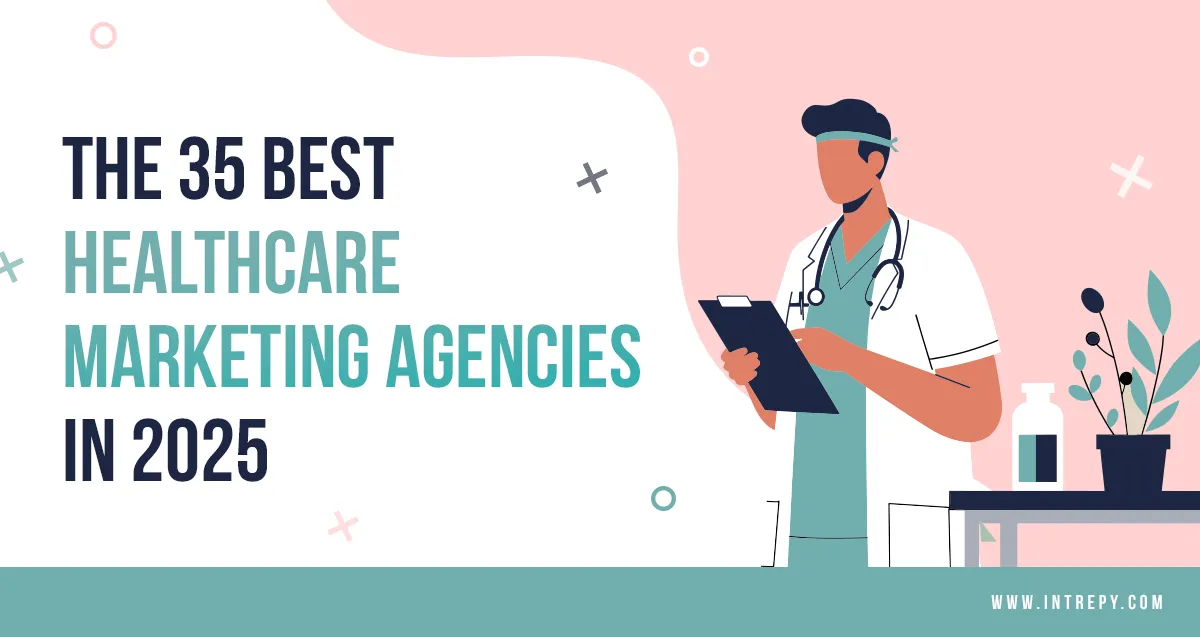TL;DR — SEO for Doctors in 2025
SEO is harder because of two shifts: technology advances (AI-driven search) and patient behavior changes (longer, conversational queries). Winning SEO now means being the source AI engines recognize and cite. The formula: Build an AI-ready medical website. Showcase trust signals. Maintain consistent entity profiles.
Q: Why is SEO for medical practices so difficult in 2025?
A: Because two forces are colliding: technology advances and shifting patient behavior. AI-generated results from Google and tools like ChatGPT and Perplexity now influence visibility, while patients are performing voice searches in longer, more conversational ways. Practices must adapt their SEO to meet the needs of both AI systems and real-world patient queries.
Why SEO for Doctors Feels Harder Than Ever
Technology Advances
Not long ago, SEO for healthcare providers was fairly straightforward: build a website, optimize your Google Business Profile, collect reviews, and publish blogs. That was usually enough to land near the top of Google results. Then AI overviews and generative models started rewriting the rules. Fast forward to 2025, and the majority of patients still use Google, but the results they see look very different. Google AI Overviews now generate summaries in their own words, though pulled from existing websites. And sometimes they’ll credit the source with a link, sometimes not. At the same time, a growing share of patients are turning directly to AI platforms like ChatGPT and Perplexity for healthcare advice.
Behavioral Changes
Alongside these shifts in technology, patient search behavior has transformed. Powered by voice technology, people no longer solely rely on individual keywords. They talk. And when they talk, they use many more words. Patients now ask questions in natural language, much like they would in the exam room with a referring physician: “Who’s the best dermatologist near here for acne scars?” or “Which orthopedic clinic is best for hip pain for seniors?” They expect answers that are instant, specific, and human, because that’s exactly how they’re searching.
The Shift
SEO for doctors in 2025 isn’t just about position on a page. It’s about making sure your practice is the trusted source that AI engines recognize and choose to cite, meeting today’s tech-savvy patients in the natural, conversational ways they search.
To help you and your practice adapt, this guide walks through the 12 most effective SEO and AI visibility strategies for medical practices in 2025, complete with real-world examples, visual recommendations, and step-by-step actions for providers, practice managers, Marketing Directors and MSO or equity partners.
Table of Contents
- Build an AI-Ready Medical Website
- Optimize Online Reviews for Local SEO for Doctors
- Maximize Google Business Profile (GBP) for Medical Practices
- Build a Strong Multi-Platform Entity Presence
- Publish Conversational, Question-Based Content
- Use Video for SEO and AI Training
- Use AI-Driven Keyword & Topic Research
- Leverage Reviews + Testimonials as Fresh Content
- Build an AI-Optimized Content Marketing Strategy
- Earn High-Authority Backlinks
- Future-Proof with Compliance & Trust Signals
- Calculate ROI of Medical SEO in the AI Era
1. Build an AI-Ready Medical Website
Your website remains the cornerstone of SEO for medical practices, but in 2025, it must be structured for both Google and AI interpretation, as well as for human visitors.
Why AI-Ready Sites Matter:
Google’s AI Overviews and LLMs (Large Language Models, such as ChatGPT and Perplexity) rely heavily on structured, machine-readable, behind-the-scenes website markup called ‘schema’ or ‘structured data’. A schema-rich medical website increases the chance of your practice being cited directly in AI-generated results.
How To Do It:
- Use MedicalOrganization, Physician, MedicalSpecialty schema on your website
- Ensure schema matches the on-page content
- To map relationships clearly (ex: Physician + Medical Procedure) used nested schema
- Ensure practice and physician pages schema matches 3rd party directories
Real Example: A Texas dermatology clinic implemented structured schema. Within months, their website appeared in Google AI Overviews for “What dermatology clinic treats acne in Dallas?”
What This Means For Your Practice:
Schema and structured data are special layers of code added to your site that act like labels. They help AI understand your website. Patients don’t see the code, but search engines and AI assistants do. If your site is clearly labeled with schema and structured for machine readability, AI is much more likely to pick your practice when it answers the patients’ questions.
Q&A
Q: Do patients see schema on my website?
A:No. Schema is invisible to patients, but it labels your site in a way search engines and AI can read. It’s like giving AI a cheatsheet for your practice so it knows exactly who you are and what you treat.
Q: Which schema types matter most for a multi-physician practice?
A: Start with MedicalOrganization (the practice), Physician (each provider), and MedicalSpecialty (your core areas). Linking them together with nested schema helps AI connect your doctors, your services, and your practice into one trusted entity.
In the screenshots below, you will see an example of a large dermatology website that we at Intrepy Healthcare Marketing built. After the launch and implementation of the above strategies, they rank #1 in map and list results for “best dermatology office” in their locality in ChatGPT.
2. Optimize Online Reviews for Local SEO for Doctors
Spoiler: this isn’t something new. Reviews are central to local SEO for doctors, and they always have been, ever since the concept existed. But now reviews also directly influence AI citations.
Why Optimized Online Reviews Matter:
AI search engines pull review language into their summaries. If patients consistently mention “compassionate care,” “hip replacement,” or “short wait times,” in their review, those terms can appear in AI Overviews.
How To Do It:
- Encourage patients to mention specific conditions/treatments in reviews.
- Collect reviews across multiple sites: Google, Healthgrades, Yelp, and Zocdoc (if you’re paying for the ZocDoc service).
- Display reviews on service pages to add keyword-rich content and enhance search engine optimization (SEO).
Real Example: A Georgia dermatology group guided patients to leave reviews mentioning “acne scar treatment.” Soon after, their practice began appearing in Google AI responses to “best dermatologist for acne scars in Athens.”
What This Means For Your Practice:
Reviews are a consideration for AI to select content. The words your patients choose directly affect how your practice is described in search results. By encouraging reviews that mention specific treatments, you increase the odds your practice shows up when someone searches for that exact service.
Q&A
Q: Why should I ask for reviews in the first place?
A: Online feedback improves both visibility and credibility. Practices with frequently updated and positive reviews tend to rank higher in local search results, and AI assistants are more likely to cite them.
Q: Which sites are most important for reviews?
A: Google Reviews are still the most important as they feed directly into search and AI summaries on Google. Healthgrades and Yelp help reinforce your credibility on non-Google platforms. Zocdoc, being a paid platform, is only available if your practice actively uses it for scheduling appointments.
3. Maximize Google Business Profile (GBP) for Medical Practices
Your Google Business Profile is a very important factor in local SEO for doctors. In 2025, it will also serve as your primary entity anchor for AI engines (Gemini and Perplexity) that pull from the Google content ecosystem.
Why GBP Matters:
Google’s AI Overviews frequently pull structured data like services, hours, and testimonials directly from GBP. A fully built-out profile can give you better visibility.
How To Do It:
- Make sure your GBP name and address match EXACTLY the same info on your website
- Add detailed services (e.g., “sports physicals,” “varicose vein surgery”).
- Add appointment and telehealth links.
- Post updates/photos monthly.
Real Example: A New Jersey vein clinic added “leg swelling treatment” and “ulcer care” as services in GBP. Google AI began surfacing its practice in “Who treats leg ulcers near me?” queries.
What This Means For Your Practice:
Think of your GBP as your digital office suite in the Google building. It’s often the first (and sometimes the only) place patients see you online. If your profile is incomplete, outdated, or missing services, you’re effectively turning patients away before they ever reach your website.
Q&A
Q: How often should I update my Google Business Profile?
A: At least once a month. Posting updates, photos, or service changes signals to Google and AI that your practice is active and reliable.
Q: What’s the most critical part of GBP to focus on?
A: Your services list. That’s where you spell out precisely what you treat or offer, and AI often pulls directly from that section when answering patient questions.
4. Build a Strong Multi-Platform Entity Presence
SEO for healthcare clinics and medical practices now depends on entity validation across the web. This part isn’t about reviews (we already covered that), and it’s not about Google Business Profile (we covered that, too). Here, we’re referring to the other profiles your practice and providers maintain across various platforms.
Why a Multi-Platform Presence Matters:
Google and AI engines cross-check LinkedIn, Healthgrades, Zocdoc (if you’re paying for it), Vitals, hospital directories and state licensing boards to confirm your credibility. When the information matches everywhere, AI can confidently connect the dots and treat your practice as a trusted entity.
How To Do It:
- Claim and complete profiles on Healthgrades, Vitals, Doximity, and Zocdoc (if you use the platform).
- Keep your LinkedIn business page and provider profiles up to date.
- Make sure your practice appears in local chamber of commerce directories and hospital directories.
- Use the same name, address, phone number, and provider details everywhere.
Real Example: Urology Partners of North Texas maintains uniform profiles across directories and LinkedIn. They frequently appear in Perplexity’s top results for “urology practice in Dallas-Fort Worth.”
What This Means For Your Practice:
Think of this as digital consistency. If a patient looks you up on three different sites, they should see the same information. That same consistency is what gives AI engines confidence to surface (show) your practice in search results. If the details don’t match, you risk appearing as multiple entities, or not showing at all because the platforms are confused. Overall, inconsistency will lower your visibility.
Q&A
Q: Isn’t my website enough for patients to find me?
A: It really isn’t anymore. AI assistants and search engines rely on multiple sources to double-check your practice is honest and trustworthy. A strong website is essential, but without matching profiles elsewhere, AI may not connect all the dots back to you.
Q: How often should we update these profiles?
A: Review them at least twice a year, or immediately if something changes (like a phone number or website link to you). Even minor inconsistencies can weaken your visibility in AI and search results.
5. Publish Conversational, Question-Based Content
One key tactic for Google search and AI visibility that has increased in importance recently is adding FAQ blocks to your website. Let’s deep dive into how to make those FAQs work hard for you. The shift to AI visibility for doctors means content must match patient questions, not just keywords.
Why Conversational, Approachable Content Matters:
AI engines prioritize content phrased in natural, patient language. Patients no longer tend to search for “spinal surgery options”; instead, they ask, “When should I see a doctor for severe back pain?” If your content answers those kinds of questions clearly, you’re more likely to be cited in AI summaries.
How To Do It:
- Reframe content around FAQs, using real patient phrasing, such as “What kind of doctor treats osteoporosis?” or “How long is recovery from knee replacement?”
- Embed FAQ blocks on service pages and answer the top 3–5 questions patients ask about conditions and treatments.
- Keep the reading level simple, aiming for an 8th-grade reading level, so it’s easy for patients and accessible for AI parsing (reading).
- Draw from patient communications, including patient exam room questions, front desk feedback and call logs or MedChats to identify the FAQs that matter most.
Real Example: A spine surgery group retitled its content from “Spinal Surgery Options” to “When Should I See a Doctor for Back Pain?” Their site began appearing in Houston AI Overviews for queries related to spine care.
What This Means For Your Practice:
FAQs aren’t filler content; they’re the way patients search. When you write answers in plain language, you make your practice more findable in AI results, and you save staff time by pre-answering common questions patients usually call about.
Q&A
Q: Why do I need FAQ sections on my website?
A: FAQ pages serve two key purposes: they often appear in “People Also Ask” sections and voice assistant responses, and when properly structured, they can drive highly relevant traffic directly to your site.
Q: How many FAQs should I include on each service page?
A: Aim for at least 3–5 FAQs per service page. Start with the questions your front desk hears most often; those are the same questions patients type into Google or AI assistants.
Q: Should the answers be short or detailed?
A: Both matter. Keep the first sentence short and direct (so AI can lift it easily), then expand with a few more details for patients who want more context.
6. Use Video for SEO and AI Training
Video is no longer just a bonus for your website. In 2025 and 2026, it will be a core part of SEO for medical practices, playing a direct role in how AI engines surface content. Having video on your site can lend authenticity to your practice, allowing your potential patients to put a face to the name and increasing both trust and your online visibility.
Why Video Matters:
Google AI often embeds YouTube videos directly into AI Overviews, and assistants like ChatGPT and Perplexity prefer citing content that exists in multiple formats. A short, clear video makes your content more visible and helps patients understand your services faster.
How To Do It:
- Record FAQ videos answering common patient questions in 30–60 seconds.
- Add transcripts and tag the video with VideoObject schema so AI can parse it.
- Embed the video on the matching service page and upload it to YouTube for maximum reach.
- Keep production simple; a doctor explaining a concept in their office is often more effective than an over-produced ad.
Real Example: A pediatric ENT clinic posted a short video on “Signs of Sinus Infection in Kids.” That video was embedded in a Google AI Overview, driving a 40% traffic increase.
Bonus Tip: For massive leverage on video marketing for doctors, check out Intrepy’s CaptureMD video production tool for Doctors. It allows production of unlimited branded videos for just $100 a month.
What This Means For Your Practice:
Think of video as “show and tell” for both patients and AI. Patients get answers in a more human way, and AI engines see a richer piece of content that’s more likely to be pulled into results.
Q&A
Q: Do I need professional equipment to film these videos?
A: No. A smartphone and good lighting are usually enough. What matters most is clarity, both in what you say and how easy it is to hear and see you. And don’t forget to smile 🙂
Q: How long should each video be?
A: Keep it short and focused: 30–60 seconds is ideal. That’s long enough to answer a question clearly but short enough for AI and patients to stay engaged.
7. Use AI-Driven Keyword & Topic Research
Keyword research has changed. Instead of short, generic terms like “orthopedic doctor,” patients are asking long, conversational questions in Google and AI assistants. To stay visible, your content needs to match those real queries.
Why AI-Driven Keywords Matter:
AI engines like ChatGPT,Perplexity and Gemini prioritize content that directly answers patient questions. Traditional keyword tools alone don’t reveal this; you need to combine them with AI-driven research tools that reflect how people actually phrase their health concerns.
How To Do It:
- Mine your own data: review call logs, emails, and your own notes to see how patients describe their symptoms or needs.
- Utilize AI tools such as AlsoAsked, AnswerThePublic, and Perplexity to identify the exact questions patients type or speak into search.
- Build content clusters that mirror the patient journey: how to prevent football injuries, how to recognize football injuries, how to recover from football injuries
- Update pages regularly. Patient queries change over time and AI tools notice fresh content and prioritize it over dates pages.
Real Example: A Kansas City orthopedic practice built football-injury topic clusters. Their content ranked in AI answers to “How can athletes prevent football knee injuries?”
What This Means For Your Practice:
You don’t have to guess what patients are searching for. By examining the exact words and questions they use, you can tailor your content to match. When your content mirrors patient language, it’s easier for both Google and AI assistants to recognize your practice as the answer
Q&A
Q: Aren’t keyword tracking tools enough to look at?
A: They’re helpful, but they mainly track keywords and short phrases. Patients are now asking full-sentence questions, and AI engines prioritize that phrasing. Tools like AlsoAsked or Perplexity reveal those longer queries.
Q: How many content clusters should I build?
A: Start with 3–4 clusters based on your highest-value services. Each cluster should include content that covers the journey from symptoms through treatment, so you are more likely to become a source that AI can cite.
8. Leverage Reviews + Testimonials as Fresh Content
Reviews double as fresh content for SEO for doctors.
Why Testimonials Matter:
New reviews keep your site and GBP “fresh” in Google and AI’s eyes.
How To Do It:
- Automate review requests if you are not doing so already with a reputation management tool
- Feature rotating reviews on service pages, pulled in from public review platforms
- Add video testimonials from patients (don’t forget a HIPAA Media Release beforehand)
Real Example: A Houston spine surgeon posted most recent patient testimonials on his site. ChatGPT began citing those reviews when patients asked about best spinal fusion recovery.
What This Means For Your Practice:
Fresh reviews and testimonials act like regular check-ins with search engines and AI. They demonstrate that patients are actively engaging with your practice today, not years ago, which makes your practice more trustworthy to both patients and AI systems.
Q&A
Q: How often should I update reviews or testimonials on my site?
A: Aim to refresh them monthly. Even one or two new reviews featured on a service page can signal to AI that your content is active.
Q: Are video testimonials worth the effort?
A: Yes. Videos give patients a more personal connection, and AI tools treat video + transcript content as a stronger signal than plain text alone.
9. Build an AI-Optimized Content Marketing Strategy
SEO for medical practices now requires topical authority to win AI citations.
Why An AI-Optimized Content Strategy Matters:
AI Overviews on Google usually summarize from comprehensive, authoritative website hubs. They do not typically display individual locally-based blogs that are not part of an overarching pillar blog + supporting topics blog strategy. Perplexity has started to show a pattern of including a mid-tier local blog for variety if it’s structured correctly for AI, and the website meets authority criteria.
How To Do It:
- Create pillar pages with supporting blogs.
- Link pillar pages and supporting blogs to each other. Ex: top 10 list links to sub topics.
- Cover symptoms → diagnosis → treatment → recovery in every post.
- Add structured FAQs with schema.
Real Example: Georgia Derm built a “Skin Cancer Resource Hub.” Their content now ranks in Google AI answers to “How do I know if a mole is cancerous?”
What This Means For Your Practice:
Think of a content hub as a digital version of how you’d explain a condition to a patient in the exam room. Start with symptoms, move through diagnosis, then outline treatment and recovery. When you organize content this way, AI sees you as the authority and someone who can present the full range of information. This means the platform is more likely to recommend your practice.
Q&A
Q: What’s the difference between a blog and a content hub?
A: A blog is a single article. A content hub is a collection of interconnected pages: a pillar page, along with supporting blogs, FAQs, and videos. Together they provide in-depth coverage of a topic.
Q: How many hubs should my practice build?
A: Start with your top 3-4 revenue-driving services. Build one hub at a time, and expand once you see results in search visibility and patient inquiries.
10. Earn High-Authority Backlinks + Citations
Backlinks remain essential for SEO for medical practices and clinics in 2025.
Why Backlinks Matter:
AI engines use citations from trusted medical and local sources as credibility signals. If a well-known website links to you from their site, this transfers some domain authority credits from their site to yours.
How To Do It:
- Doctors or their staff can pitch the office to local news as expert sources.
- Contribute guest blogs to associations and patient advocacy groups.
- Secure incoming website links from hospital partners or other trusted affiliates
Real Example: A Miami cardiologist was quoted in a Miami Herald online article on heart health. That backlink boosted his visibility, and Gemini AI cited his clinic in “How do I prevent heart disease?”
What This Means For Your Practice:
Think of backlinks like referrals, but online. Just as patients trust a doctor more when another physician refers them, search engines and AI trust your practice more when credible websites point back to you.
Q&A
Q: Which backlinks are the most valuable for a medical practice?
A: Links from hospitals, universities, medical associations, and respected local news outlets are the most impactful. They signal both authority and trust.
Q: How often should I work on getting new backlinks?
A: Aim for at least one new high-quality backlink per quarter. Quality matters more than quantity. One strong link from a hospital or news site is worth more than dozens of low-quality links.
BONUS: Need help with backlink building? Intrepy can help.
11. Future-Proof with Compliance & Trust Signals
In healthcare, compliance isn’t just about avoiding penalties, it’s also a visibility signal. AI assistants and patients alike favor practices that demonstrate transparency, safety, and professionalism.
Why Compliance Matters:
AI tools are designed to avoid citing questionable or non-compliant sources. If your site lacks trust signals, you risk being ignored by both search engines and patients. On the other hand, clearly showing your compliance and credibility can give you an edge.
How To Do It:
- Highlight compliance: Make HIPAA compliance, board certification, and patient privacy commitments visible on your site.
- Show trust signals: Display awards, accreditations, or affiliations (with permission to use their logos).
- Use consistent disclaimers: Clearly state that information on your site is for educational purposes, not a substitute for medical advice.
Real example: A behavioral health group prominently displayed its LegitScript accreditation badge and clear HIPAA statement on its website.
What This Means For Your Practice:
Compliance isn’t just a legal checkbox, it’s part of your online reputation. By showing patients (and AI) that you take privacy, safety, and accreditation seriously, you’re more likely to be trusted and cited as a reliable source.
Q&A
Q: Do patients really notice compliance badges and certifications?
A: Yes. While patients may not understand every detail, seeing familiar accreditations like “Board Certified” and “HIPAA compliant” builds trust and reassures them about the quality of care.
Q: What’s the biggest compliance mistake practices make online?
A: Using patient testimonials with identifiable health information and incentivizing reviews. Both can create HIPAA risks and damage credibility.
12. ROI of SEO for Medical Practices in the AI Era
At the end of the day, though we live and breathe medical SEO and healthcare AI visibility every day, we know that doctors and practice leaders don’t honestly care about “rankings”; they care about new patients, revenue, outcomes, and patient experience. Measuring ROI for SEO activities in 2025 means looking at the numbers that actually matter to your practice, not vanity metrics.
Why ROI Matters Now More Than Ever:
AI search and SEO efforts can drive significant patient growth, but only if you track the right indicators. By focusing on patient-centered metrics, you can see whether your investment in SEO is leading to real results.
How To Do It:
- Track new patients per month coming from online sources.
- Measure the percentage of appointments booked online, including AI-driven and GBP funnels.
- Monitor kept appointment rates to see if patients coming through digital channels keep their visits.
- Calculate the cost per lead (CPL) and cost per acquisition (CPA) in relation to case profitability or patient lifetime value to understand the actual efficiency and ROI of Medical SEO.
Real example: A urology group tracked patients booking through their online self-scheduling system. After optimizing for AI visibility and FAQs, they saw a 20% increase in online bookings and a 10% reduction in patient acquisition cost.
What This Means For Your Practice:
SEO in 2025 should be judged like any other business investment. If it’s not bringing in measurable patient growth, then it’s not working. By tying SEO directly to patient volume, show-up rates, and acquisition costs, you can clearly see the return on your efforts.
Q&A
Q: What’s the most important metric to track?
A: New patients per month. It’s the clearest signal of whether SEO and AI visibility are actually delivering growth for your practice.
Q: How soon should I expect to see ROI from SEO changes?
A: Most practices start to see meaningful changes within 3–6 months, though building long-term authority and AI visibility can take 9–12 months.
Conclusion: SEO + AI Visibility = Patient Growth
SEO for doctors in 2025 is no longer just about ranking on page one of Google. It’s about being the trusted source that AI assistants and Google AI Overviews cite across a broad spectrum of platforms.
The 3-Part Formula for Success in AI Visibility for Doctors:
- Build a Strong Foundation with a fast, mobile-friendly website, with medical schema FAQs, and content optimized for machine readability and patient engagement. content and consistent profiles across platforms.
- Earn Trust Signals through patient reviews, credible backlinks, and visible compliance such as board certification and HIPAA adherence.
- Maximize local and AI visibility by optimizing your GBP presence, ensuring consistent information across 3rd party platforms, and periodically updating profiles
Bottom line: Doctors and Medical Practices who adopt this three-part formula for AI visibility will future-proof their practices, strengthen patient acquisition, and maintain visibility in both traditional search and AI-driven discovery.
Next Step: Overwhelmed and want us to take care of this for you?
Book a practice acceleration session with one of our medical SEO/AI experts and get a personalized roadmap on how to improve your medical practice AI visibility and search ranking for new patient acquisition.
About The Author
By Tomi Barton, Chief Marketing Officer, Intrepy Healthcare Marketing
Tomi Barton is the Chief Marketing Officer at Intrepy Healthcare Marketing, where she leads patient acquisition, ROI-driven digital strategies, and brand growth for medical practices across 40+ specialties. With training from Cambridge Marketing College and a Master’s in Internet Marketing from USF, she combines clinical literacy, marketing expertise, and AMWA-trained medical writing skills to create content and campaigns that build strong healthcare brands and measurable growth. She specializes in healthcare strategy, direct-to-patient marketing, AI visibility, and ROI optimization for physicians and specialty medical practices.
